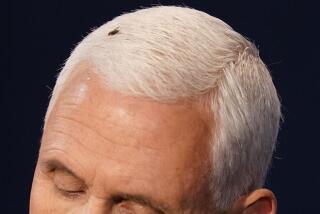Tell-back Tells All About Voter Reaction
- Share via
NEW YORK — While pundits pondered and political spin doctors readied verbal swirls Thursday night in Los Angeles, 90 voters sat in a TV studio far to the north, recording their moment-to-moment gut reactions to the second and final presidential debate they were seeing on TV.
Each had a dial connected to a computer that generated an electronic bar graph. If they liked what Vice President George Bush was saying, they turned the dial right; if they liked what Gov. Michael Dukakis was saying, they turned it left. The green-colored graph was superimposed on station KHQ’s debate broadcast to give viewers an instantaneous majority report on how the candidates were faring.
The unique on-air use of the instant-reaction device, known as a Tell-back, “was an experiment,” Dean Mell, news director of KHQ in Spokane, Wash., said in a phone interview Friday.
But it could be common at the end of the century, added Mell, who from 1962 to 1973 was an NBC News correspondent, working mostly in radio.
“I think in the long run we’ll all be doing this from our homes some day,” he said. “When you get interactive cable, fiber-optic tie-ups and all that, by the year 2000 we won’t have to gather 70 or 90 people together.”
iewers will be able to sit at home and record their reactions to presidential debates as easily as “we now switch channels around with our zappers,” he said.
NBC, with which his station is affiliated, aired a brief report on the experiment in its post-debate wrap-up.
The Tell-back system is similar to others that some networks, studios and Preview House, an audience-reaction company in Los Angeles, have used for years to test audience reactions to films, TV pilots and commercials. Tell-back was invented by a Spokane resident, Tom Westbrook, a one-time local TV reporter and former Gonzaga University speech and communications teacher.
Westbrook said he has been working on it since 1974. “My interest in this whole thing was to make palpable the notion of response” by viewers, he said.
The idea, he said, is to record how a viewer feels about what the candidate says on a given issue at the exact moment the candidate discusses that issue.
Westbrook said he disliked so-called “spin doctors,” the political functionaries who meet with reporters and try to put the best possible “spin” on whatever their candidates have said or done, in hopes of favorably influencing readers and viewers.
“I believe the role of the spin doctors has come to be rather dangerous,” Westbrook said. “These people get up and go to work to distort reality. . . . They ask us to doubt our own perceptions and try to impose their own. . . .”
The Spokane participants were 47 women and 43 men whom Mell described as political “middle-of-the-roaders.” Before the debate, 43 of them said they were leaning to Bush, 41 to Dukakis and six were undecided, Mell said.
While an ABC News post-debate poll of 639 voters declared Bush the winner--49% to 33%, with 18% calling it a tie--the Tell-back viewers saw it differently. Fifty thought Dukakis won, 30 favored Bush, 10 weren’t sure.
(They didn’t see the entire debate, however. An anonymous caller who said a bomb would go off in the station at 7:30 p.m. PDT forced the evacuation of KHQ studios just before Bush and Dukakis made their closing arguments. Police found no bomb, Mell said.)
“Essentially, the women, fairly consistently, were in Dukakis’ corner and the men fairly consistently were with Bush,” Mell said. “But surprisingly--or maybe not--both men and women went to Dukakis on the abortion issue. That was probably the biggest swing for anybody--the abortion issue.”
Dukakis supports the right of women to choose to have abortions, while Bush opposes abortion, except in limited situations.
Mell conceded that political scientists and others may consider Westbrook’s Tell-back system sort of an instant-gratification machine that is the last thing the public needs in an era of complex issues.
“I view it a little differently,” he said. “I would see it as letting us get away from the so-called expert analysts telling the rest of us how we’re supposed to feel about these issues.”
“A viewer at home can see how fellow voters with no particular expertise are reacting, and they may very well identify with what they’re seeing on the screen. . . . They may take some confidence in their own judgment.”
As this sort of quick-response system becomes commonplace, he predicted, it “not only will affect politics, but it’ll affect everything--commercials, programming, a whole lot of things. And I don’t know if there’s anything that can be done about it. The technology exists.”
More to Read
Get the L.A. Times Politics newsletter
Deeply reported insights into legislation, politics and policy from Sacramento, Washington and beyond. In your inbox twice per week.
You may occasionally receive promotional content from the Los Angeles Times.









